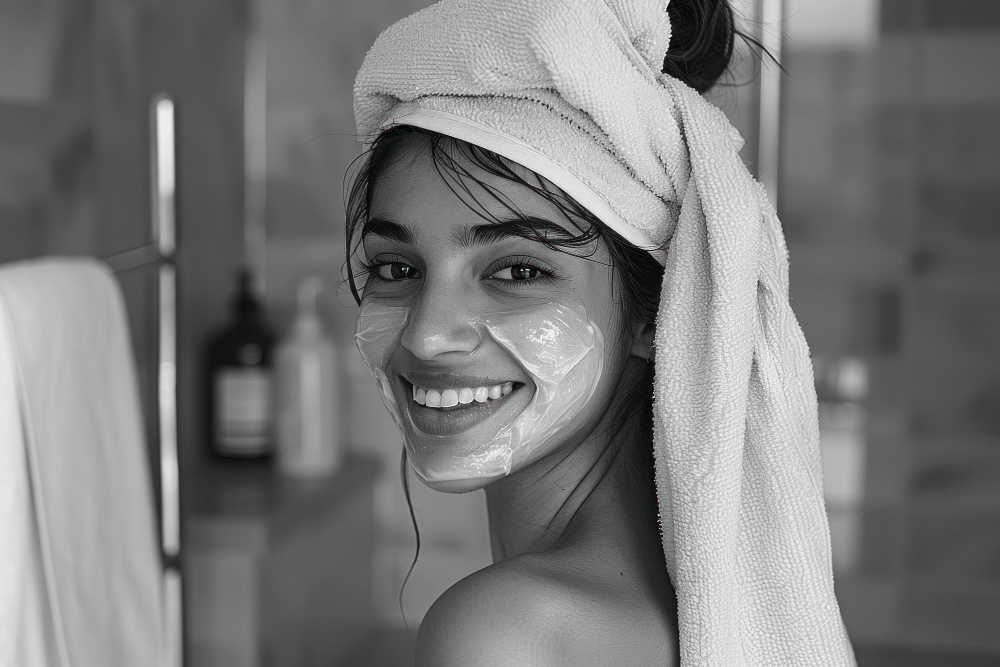Remember when you thought turning 30 meant your skin would suddenly transform overnight into something requiring immediate intervention? Yeah, me too. Spoiler alert: that’s not how any of this works, despite what every skincare ad wants you to believe.
Let’s be real about what healthy skin actually looks like when you’re not 22 anymore
The 30s Skin Reality Check
Let’s start with some honesty. Yes, things are changing. Around 30, your skin starts producing about 1% less collagen each year. Your cell turnover rate, which was humming along at about 28 days in your twenties, starts slowing down. The natural oils that kept your skin plump and glowy? They’re not flowing quite as freely.
But here’s what nobody talks about: this isn’t a tragedy requiring emergency measures. It’s just your skin entering a new phase, and honestly? This phase can be pretty amazing if you know how to work with it instead of against it.
Think about it this way – your skin in your 30s is like a well-loved leather jacket. It’s developing character, becoming more interesting, and with the right care, it can look absolutely stunning. The key is learning to appreciate its new personality rather than trying to force it back to its teenage self.
Redefining “Youthful”
Here’s where we need to have a serious conversation about what “youthful” skin actually means. Spoiler: it’s not about being wrinkle-free or having the texture of a baby’s bottom.
Real youthful skin in your 30s looks like:
Healthy radiance over artificial perfection. That glow doesn’t come from having zero texture – it comes from skin that’s well-hydrated, protected, and functioning optimally. Think less “Instagram filter” and more “just came back from a great vacation.”
Resilience over rigidity. Youthful skin bounces back. It handles stress, weather changes, and the occasional late night without having a complete meltdown. It’s flexible, adaptable, and strong.
Confidence over coverage. The most youthful thing about your skin? How comfortable you feel in it. When you stop obsessing over every tiny imperfection and start appreciating what your skin does for you every day, that confidence literally shows.
The Biggest Myths We Need to Bust Right Now
Myth #1: You Need to Panic About Prevention The beauty industry loves to sell us on this idea that 30 is some kind of skincare emergency. “Start anti-aging NOW or it’s too late!” they scream. This is nonsense. Your skin didn’t suddenly become fragile the moment you blew out those 30 candles.
Myth #2: More Products = Better Results We’ve been conditioned to think that “taking skincare seriously” means having a 12-step routine with products that cost more than your monthly grocery budget. Reality check: your skin doesn’t need to be overwhelmed with actives to stay healthy.
Myth #3: Natural Aging is the Enemy Here’s a radical thought: maybe some signs of aging are actually… normal? And maybe, just maybe, a few laugh lines are more attractive than the frozen, over-treated look that comes from trying to stop time entirely.
What Your Skin Actually Needs in Your 30s
Let’s talk about what actually matters for maintaining healthy, vibrant skin in your 30s. And no, it’s not about building a skincare routine that requires a spreadsheet to track.
Consistency Over Intensity Your skin craves routine more than it craves the latest miracle ingredient. A simple, consistent routine that you actually stick to will always beat the most expensive products that sit unused in your bathroom cabinet.
Protection Over Correction The most youthful thing you can do for your skin? Protect it from further damage. Daily sunscreen (yes, even in winter, even when working from home) is worth more than any anti-aging serum.
Hydration Over Everything Well-hydrated skin looks plump, healthy, and yes, more youthful. But we’re not just talking about chugging water (though that helps). Your skin needs moisture both inside and out, and finding the right balance for your skin type is key.
The Science Behind 30s Skin (Without the Scary Marketing)
Let’s get nerdy for a minute, but in a way that actually helps you understand what’s happening rather than selling you something.
Your skin is becoming more sophisticated in its needs. The same ingredients that worked in your twenties might feel too harsh now, while others that seemed unnecessary are suddenly game-changers.
Your skin’s barrier function is also evolving. It might be more sensitive to certain ingredients or environmental factors, but this isn’t weakness – it’s specificity. Your skin is becoming more discerning about what it needs.
The trend toward personalized skincare isn’t just marketing hype – your skin really is becoming more individual in its needs. What works for your best friend might not work for you, and that’s completely normal.
Building a Realistic Routine That Actually Works
Forget the 10-step Korean skincare routine (unless that genuinely brings you joy). Here’s what a realistic, effective routine for 30s skin actually looks like:
Morning: The Non-Negotiables
- Gentle cleanser (or just water if your skin is dry)
- Moisturizer that makes your skin feel comfortable
- Sunscreen. Every. Single. Day.
That’s it. Three steps. If you want to add a vitamin C serum for extra antioxidant protection, great. If not, you’re still doing everything your skin actually needs.
Evening: Wind Down and Repair
- Remove makeup/sunscreen thoroughly but gently
- Cleanse if needed
- A treatment product if you want (retinol, AHA, whatever your skin tolerates well)
- Moisturizer
- Face oil if your skin is dry
Notice what’s missing? The panic. The urgency. The feeling like you’re fighting against time.
The Lifestyle Factors That Actually Matter
Here’s what the skincare industry doesn’t want you to know: the most impactful things you can do for your skin in your 30s aren’t products you can buy.
Sleep quality matters more than most serums. During deep sleep, your skin goes into repair mode, producing growth hormones and repairing daily damage. Seven to eight hours of quality sleep will do more for your skin than any night cream.
Stress management isn’t just good for your mind. Chronic stress increases cortisol levels, which breaks down collagen and triggers inflammation. Finding healthy ways to manage stress – whether that’s yoga, meditation, or just taking regular breaks – shows up on your face.
Movement and circulation. Regular exercise increases blood flow, delivering oxygen and nutrients to your skin cells while helping flush out toxins. You don’t need to become a fitness influencer – just find ways to move your body that you enjoy.
When to Actually Worry (Spoiler: It’s Less Than You Think)
There’s a difference between normal skin changes and signs that you might want to check in with a professional. Here’s when to pay attention:
Sudden, dramatic changes in your skin that don’t correlate with any lifestyle or product changes deserve attention. We’re talking about new sensitivity, persistent redness, or changes in moles or spots.
Skin that’s consistently uncomfortable – constantly tight, itchy, or irritated – might need professional evaluation to rule out underlying conditions.
Products that consistently cause reactions might indicate that your skin’s needs have changed or that you’ve developed new sensitivities.
But normal signs of aging? The gradual changes that happen over months and years? Those are just your skin living its life, and they’re completely normal.
The Real Secret to Youthful Skin: Changing Your Mindset
Here’s the truth bomb nobody wants to hear: the most youthful thing about your skin isn’t how it looks – it’s how you feel about it.
When you stop scrutinizing every pore in 10x magnifying mirrors and start appreciating what your skin does for you every day, something magical happens. You start glowing from the inside out.
When you choose products based on how they make your skin feel rather than what they promise to fix, you start building a routine that actually serves you.
When you stop comparing your real skin to filtered Instagram posts and start celebrating your own skin’s unique beauty, you radiate confidence that no serum can provide.
Moving Forward: Your 30s Skin Action Plan
So what does all this mean for your actual skincare routine? Here’s your realistic, shame-free action plan:
Start where you are. Don’t throw out everything you’re currently using and start over. Make small, sustainable changes over time.
Focus on the basics. Get your cleansing, moisturizing, and sun protection dialed in before worrying about anything else.
Listen to your skin. It will tell you what it needs if you pay attention. Tight and flaky? More moisture. Congested and dull? Maybe gentle exfoliation.
Give things time. Skin changes slowly. Give new products at least 6-8 weeks to show their true effects.
Remember why you’re doing this. It’s not to look 22 forever. It’s to have healthy, comfortable skin that makes you feel confident and radiant at every age.
“Youthful” skin in your 30s isn’t about turning back the clock or fighting against natural changes. It’s about working with your skin as it evolves, appreciating its new needs, and maintaining its health and vitality in ways that feel sustainable and authentic to you.
Your skin in your 30s has the potential to be the best it’s ever been – not because it looks exactly like it did a decade ago, but because you finally understand how to care for it properly. So let’s retire the panic-inducing messages about “anti-aging” and embrace a new narrative: your skin is amazing at every age, and with thoughtful care, it can continue to be healthy, radiant, and yes, youthful in all the ways that actually matter.
The glow you’re looking for? It’s not in a bottle. It’s in the confidence that comes from taking good care of yourself and embracing exactly where you are right now.

Disclaimer: Thanks for reading — from all of us at First News US. This article is for informational and lifestyle purposes only and should not be considered medical advice. Individual skin needs vary greatly, and what works for one person may not work for another. For specific skin concerns or conditions, consult with a qualified dermatologist or skincare professional. Always patch test new products and discontinue use if irritation occurs.
Sources referenced include current skincare trend analyses from industry publications and general skincare research available through 2024-2025. This content is intended for educational purposes and reflects current lifestyle approaches to skincare rather than medical recommendations.



